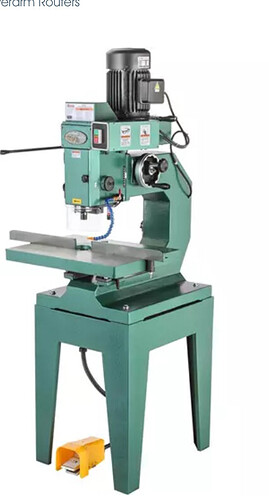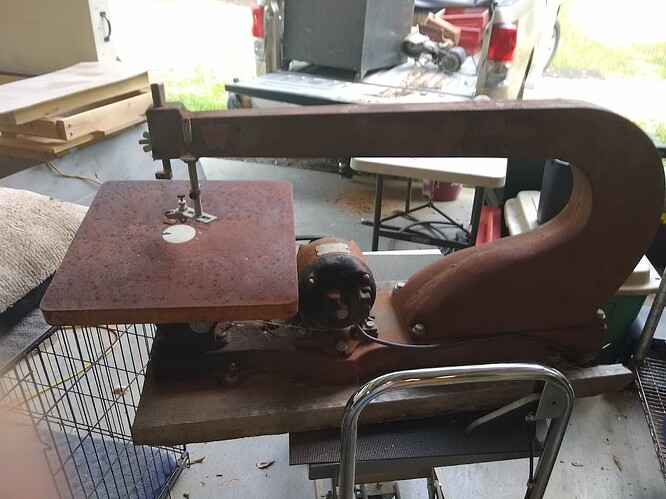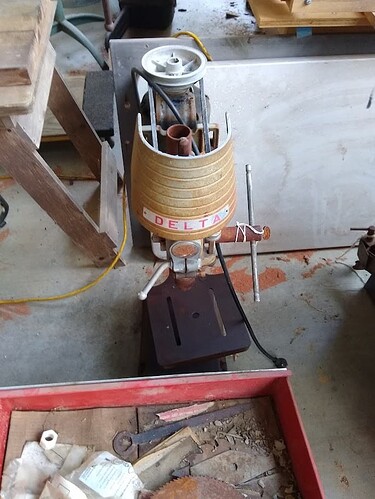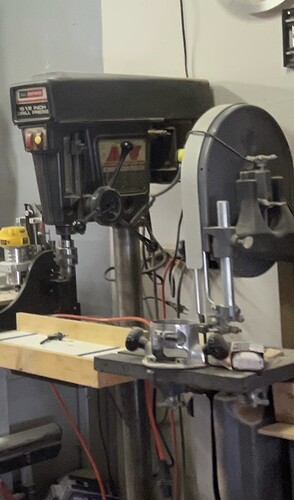I put pants on for this…
After seeing your video, I had to try again. I got it to budge by putting my full body weight into it, which is why I didn’t think it would budge. But that amount of force is akin to the force it would take to knock the machine of the table (I only have the small machine). If a failure could exert that kind of force, I think I’d have other things to worry about.
But I see your point.
You’d be surprised how much force a cutting tool rotating at many thousands of rpm will exert. Especially if it “bites” in a cut.
My professional and personal advice are in agreement here. It’s not a good idea, please don’t endanger yourself by trying. I’d be glad to share my trim router mount template that I posted above if it will help you not do this.
There is no “good” idea for using a CNC as a router table. Yes it “can” work but “can” and “do” are far apart here. This idea is just dangerous. I “can” drive with my eyes closed but it is not a very “good” idea. Anyone “can” do as they will but practically everyone in this thread has commented that using a CNC as a router table is a bad idea.
Let me repeat. Using a CNC for a router table is a BAD idea and should not be attempted.
I have to play devil’s advocate here. With the exception of the power outage issue and unlocking of the stepper motors, which I do view as a significant safety issue (I have tripped the breaker’s on my garage many times), all other safety issues brought up apply equally to table mounted routers.
If you look at the comments of that video it is quite the opposite of that here. But we can agree there are definitely safety issues they clearly are not addressing.
I’m sure all new machines are dangerous until safety considerations are addressed and safety mechanisms. If we discarded all ideas because initially they aren’t safe, our only mode of transportation would be walking and we wouldn’t have modern medicine.
So let me turn this into a hypothetical engineering question. What would it take to using a CNC as a router table safe (or at least as safe as a traditional router table)? (I do emphasize hypothetical)
So let me turn this into a hypothetical engineering question. What would it take to using a CNC as a router table safe (or at least as safe as a traditional router table)? (I do emphasize hypothetical)
Take the router out of the machine and build a table for it.
I’ll step in and say that I have done this (I didn’t want to admit it after seeing the responses). It was a one time, convenience thing. Everything went fine. It felt weird, and I can’t say that I can think of a reason why I would do it again if I have an option.
I’ve got a Z-plus I could part with if you want to build a screw-based router lift.
Just because you can, doesn’t mean you should.
While I have heard others ask about this too, it’s not a good idea. Not to pile on, we just want you safe.
This is what an overhead router looks like. They are ridiculously robust. There is a reason for it.
Now that you posted that. There is a reason overtable routing doesn’t look so foreign to me. I’ve done it before years ago. Before I had a trim router or router table (or CNC for that matter) I used to cut rabbets for shelving using my Shopsmith 510 in an overtable router configuration which is in fact advocated by Shopsmith, see Getting Started With The Router. Personally, I trust the robustness of the Shapeoko over my Shopsmith. That still doesn’t mean using a CNC over table is safe but it does mean there is nothing inherently more dangers about an over table router.
History lesson and food for thought Routers came before router tables. At one time router tables were the potentially more dangerous improvisation of router use, but as it got adopted, routers were manufacture to be more compatible with tables.
I cringe inside every time I see someone ripping stock with a radial arm saw. There’s many ways to cut a piece of wood, but some ways are safer than others.
Agree. When I was young, all we had was a Radial Arm Saw at home. We used it for everything including router/shaper. I can’t tell you just how dangerous it was. The Shop Smith is not much better as it’s an all in one tool (jack of all trades master of none). Today you can buy inexpensive tools that are way safer than using the wrong tool.
Anyway in this case, a router table can be made or bought so inexpensively that I can’t believe we are discussing this. They can be made to collapse, small enough to slip under a bench or on a shelf etc.
Certain things I won’t compromise on. My safety is one of them.
This summer I bought a Craftsman Radial Arm Saw. It needs to be torn down and cleaned and repainted. I intend to get to that this winter. I will likely just sell it. The other name for a Radial Arm Saw is Finger Chopper. Like all power tools can be dangerous the Radial Arm Saw has the potential to be one of the most dangerous. Even if you are very careful one moment of not paying attention can be disastrous. You could say the same about driving and mostly you do not turn it upside down but if you do WOW.
Every machine has its use. A good RA saw can really make a shop. Let’s face it, just about every board requires it to be cut to length or a useable length prior to any other machining. Today, most guys use a miter saw or a sliding miter saw. It’s not really the same and you can’t put a dado blade on a miter saw. They take up less space, though a RA can and usually is built into the main work bench.
My personal shop had a nice Rockwell/dewalt RA that got used a ton. It’s gone during a move and was not replaced due to space. But as you say: safety first. Never take your eye off a moving blade.
Anyways, if it’s a Craftsman with the round knob for raising and lower the blade, sell it and move on. IMO. If it has a crank on the top of the main post then it should be ok.
Just my $0.02 worth (maybe, with inflation, more than that ![]() )
)
Whether you choose to use a tool in a way that isn’t designed for the purpose is really up to you. Just please don’t try to argue others to do so nor blame anyone else but yourself when (not if, when) something goes wrong.
For me, safety is absolutely #1 and I will use tools in the safest possible manner and using the tools designed for the job with all safety precautions I can muster. While you CAN use a tool for other purposes other than those for which it was designed, it is very rarely wise to do so.
Amen…Twenty Characters.
Won’t they still pay on that as part of a recall?
The recall is over. It expired a couple of years ago. Most of the recall was about the blade guard. With Sears almost out of business you might be able to order the parts but it is doubtful. I just like to refurbish old equipment. Sometimes I use and sometimes I just sell it. I dont make a lot of profit but I enjoy rebuilding them.
I bought all 3 of these machines for $130.00
This is a Duro 30" scroll saw. I will likely just sell it to someone that wants a parts machine for a restoration. It is complete.
This is a Delta/Rockwell 11" drill press. I will definitely rebuild this one.
Here is the Craftsman Radial Arm Saw. This is a 70’s vintage and has a cabinet on the bottom instead of the open frame. The front round knob is broken. I have already drawn it up in CC and will create a wood/alumnium one to replace it. That knob is just the release for the head to swing. The lower crank lowers/raises the head. The motor runs fine and is a standard 10" 5/8" arbor blade. I have had a 12" one before.
I do the same, but seldom sell until I am tired of tripping on it. My 16” Craftsman drill press and my 14” Rockwell bandsaw required to be reworked and overhauled but are great machine and get used on every guitar I build….and them some.
I was doing some spring cleaning so there some extra tools on top of them, but here you can see those two machines






